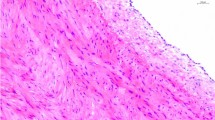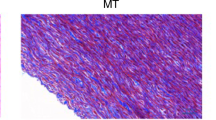Abstract
Several in vitro studies have demonstrated diminished post-thaw functional activity. Therefore, the aim of this study was to investigate the consequences of thawing and storage method used on the post-thaw functional activity of cryopreserved pig aortas with the aim of adjusting the freezing and thawing protocol so that the vascular segments are preserved in the best possible state, maintaining structure and functionality so that they can later be transplanted with success.
In vitro responses of frozen, thawed pig aortas were used to investigate the functional activity after thawing at 15 °C and 100 °C/min and after storage in gas or liquid phase of liquid nitrogen. Cryopreservation was performed in RPMI 1640 medium + 10% dimethylsulfoxide and the rate of cooling was −1 °C/min, until −150 °C was reached.
After thawing the maximal contractile responses to all the contracting agonists tested (KCl, noradrenaline) were in the ranges of 13–27% compared with the responses in unfrozen pig aortas. Contractile responses were slightly better when thawing was performed at 15 °C/min compared with 100 °C/min. The endothelium independent relaxant responses to sodium nitroprusside were reduced (P < 0.05). Cryostorage of pig arteries also resulted in a loss of the endothelium-dependent relaxant response to acetylcholine. The cryopreservation method used provided a limited preservation of pig aorta contractibility, a reduction of the endothelium independent relaxant responses, and no apparent preservation of the endothelium-dependent relaxation. It is possible that further refinements of the cryopreservation protocol might allow better post-thaw functional recovery of pig aortas.
Similar content being viewed by others
References
Elmore J.R., Gloviczki P., Brockbank K.G.M. and Miller V.M. 1991. Cryopreservation affects endothelial and smooth muscle function of canine autogenous saphenous vein grafts. Journal of Vascular Surgery 13: 584–592.
Gournier J.P., Favre J.P., Gay J.L. and Barral X. 1995. Cryopreserved arteries allografts for limb salvage in the absence of suitable sous vein: two-year results in 20 cases. Annals of Vascular Surgery 9: S7–S14.
Harris R.W., Schneider P.A., Andros G., Oblath R.W., Salles-Cunha S. and Dulawa L. 1993. Allograft vein bypass: is it an acceptable alternative for infrapopliteal revascularization?. Journal of Vascular Surgery 18: 553–560.
Hunt C.J., Song Y.C., Bateson E.A.J. and Pegg D.E. 1994. Fractures in cryopreserved arteries. Cryobiology 131: 506–515.
Ku D.D., Willis W.L. and Caulfield J.B. 1990. Retention of endothelium-dependent vasodilatory responses in canine coronary arteries following cryopreservation. Cryobiology 27: 511–520.
Ku D.D., Winn M.J., Grigsby T. and Caulfield J.B. 1992. Human coronary vascular smooth muscle and endotheliumdependent responses after storage at −75 °C. Cryobiology 29: 199–209.
Londrey G.L., Ramsey D.E., Hodgson K.M., Barkmeier L.D. and Sumner D.S. 1991. Intrapopliteal bypass for severe ischaemia: comparison of autogenous vein, composite and prosthetic grafts. Journal of Vascular Surgery 5: 631–636.
Louagie Y.A., Legrand-Monsieur A., Lavenne-Pardonge E., Remacle C., Delvaux P. and Maldague P., Buche M., Ponlot R. and Schoevaerdts J.C. 1990. Viability of long term cryopreserved human saphenous veins. Journal of Cardiovascular Surgery 31: 92–100.
Müller-Schweinitzer E. 1988. Cryopreservation: a useful technique for storing tissues for pharmacological investigations Trends in Pharmacological Sciences 9: 221–223.
Müller-Schweinitzer E. 1994. As for cryopreserved blood vessels in pharmacological research. Cryobiology 31: 57–62.
Müller-Schweinitzer E., Mihatsch M.J., Schilling M. and Haefeli W. 1997. Functional recovery of human mesenteric and coronary arteries after cryopreservation at −196 °C medium. Journal of Vascular Surgery 25: 743–750.
Müller-Schweinitzer E., Stulz P., Striffeler H. and Haefeli W. 1998. Functional activity and transmembrane signaling mechanisms after cryopreservation of human internal mammary arteries. Journal of Vascular Surgery 27: 528–537.
Nataf P., Hadjiiisky P., Lechat P., Mougenot N., Peuchmaurd M., Gouezo R., 1995. Effect of cold anoxia on cryopreservation on metabolic and contractile functions of human internal mammary artery. Cryobiology 32: 327–333.
Ochsner J.L., Lawson J.D., Eskind S.J., Mills N.L. and De Camp P.T. 1984. Homologous veins as an arterial substitute: long-term results. Journal of Vascular Surgery 1: 306–313.
Pascual G., García-Honduvilla N., Rodríguez M., Turégano F., Buján J. and Bellón J.M. 2001. Effect of the thawing process on crypreserved arteries Annals of Vascular Surgery 15: 619–627.
Passani S.L., Angelini G.D., Breckenridge I.M. and Newby A.C. 1988. Endothelial function can be preserved during cryostorage of human saphenous vein. European Journal of Cardio-Thoracic Surgery 2: 233–236.
Pegg D., Boylan S. and Wusteman M. 1995. The avoidance of fractures in cryopreserved elastic arteries (abstract). Cryobiology 32: 553.
Pegg D., Wusteman M. and Boylan S. 1996. Fractures in cryopreserved elastic arteries. Cryobiology 33: 658–659.
Pukacki F., Jankowski T., Gabriel M., Oszkinis G., Krasinski Z. and Zapalski S. 2000. The mechanical properties of fresh and cryopreserved arterial homografts. European Journal of Vascular Endovascular Surgery 20: 21–24.
Song Y.C., Hunt C.J. and Pegg D.E. 1994. Cryopreservation of the common carotid artery of the rabbit. Cryobiology 31: 317–329.
Song Y.C., Pegg D.E. and Hunt C.J. 1995. Cryopreservation of the common carotid artery of the rabbit: optimization of dimethyl sulfoxide concentration and cooling rate. Cryobiology 32: 405–421.
Stanke F., Riebel D., Carmine S., Cracowski J.L., Caron F., Magne J.L., Egelhoffer H., Bessard G. and Devillier P. 1998. Functional assessment of human femoral arteries after cryopreservation. Journal of Vascular Surgery 28: 273–283.
Vischjager M., Van Gulik T.M., Pfaffendorf M.V., Zwleten P.A., Van Marle J., Kromhout J.G. et al. 1995. Morphology and function of dog arterial grafts preserved in UW-solution. European Journal of Vascular Endovascular Surgery 10: 431–439.
Vischjager M., Van Gulik T.M., Van Marle J., Pfaffendorf M. and Jacobs M.J.H.M. 1996. Function of cryopreserved arterial allografts under immunosuppresive protection with cyclosporine A. Journal of Vascular Surgery 24: 876–882.
Wagstaff S.A. and Grigg M.J. 1996. Arterial homografts - a possible solution to an infective dilemma. Cardiovascular Surgery 4: 796–800.
Wusteman M., Busza A., Boylan S., Hayes A. and Pegg D. 1995. Ethylene glycol permeation and toxicity in the rabbit common carotid artery. Cryobiology 32: 428–435.
Author information
Authors and Affiliations
Rights and permissions
About this article
Cite this article
Vázquez, M.E.R., Rodríguez Cabarcos, M., Martinez Santos, M. et al. Functional assessment of cryopreserved pig aortas for pharmaceutical research. Cell Tissue Banking 5, 111–118 (2004). https://doi.org/10.1023/B:CATB.0000034086.89929.56
Issue Date:
DOI: https://doi.org/10.1023/B:CATB.0000034086.89929.56




